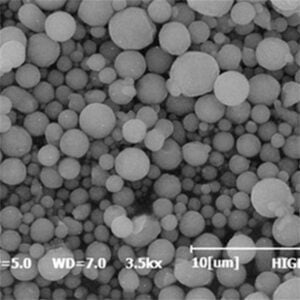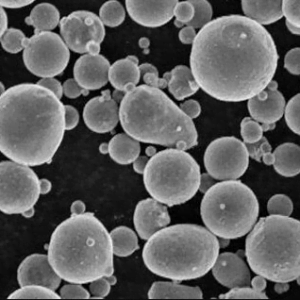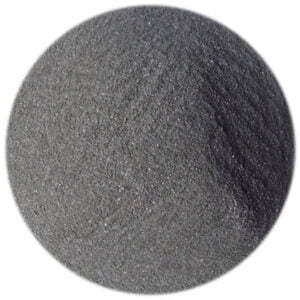3Dプリンティング金属粉末
目次
概要 3Dプリンティング金属粉
3Dプリンティング金属粉末とは、金属部品や製品を製造するためのさまざまな金属積層造形プロセスで原材料として使用される微細な金属粉末のことです。3Dプリントに使用される最も一般的な金属粉末には、ステンレス鋼、チタン、ニッケル合金、アルミニウム、コバルトクロムなどがあります。
金属粉末床融合と指向性エネルギー堆積法は、金属粉末を利用してCADモデルからレイヤーごとにパーツを構築する、金属3Dプリントプロセスの2つの主要なファミリーです。金属粉末の特性と材料特性は、最終的なパーツの品質、精度、表面仕上げ、性能に大きな影響を与えます。
主な詳細
- 一般的な金属粉:ステンレス鋼、チタン、ニッケル合金、アルミニウム、コバルトクロム
- 主な金属3Dプリントプロセス粉末床溶融法、直接エネルギー堆積法
- 部品品質に重要な粉体特性
- 用途に応じた幅広い合金オプション
- 業界を問わず、プロトタイピングや製造に最も広く使用されている。
- 複雑形状、軽量化、部品統合などのメリットを提供

金属粉末の種類と組成
様々な材料メーカーから、3Dプリンティング用に多くの標準およびカスタム金属合金パウダーが販売されています。ほとんどの合金は、積層造形プロセス専用に最適化されています。
| メタル | 一般合金 | 典型的な構成 |
|---|---|---|
| ステンレス鋼 | 316L、17-4PH、304L、420 | Fe、Cr、Ni、Mo |
| チタン | Ti-6Al-4V、Ti 6242 | Ti、Al、V、Sn |
| アルミニウム | AlSi10Mg, AlSi7Mg | Al、Si、Mg |
| ニッケル合金 | インコネル718、インコネル625 | Ni、Cr、Fe、Nb、Mo |
| コバルト・クローム | CoCrMo、CoCrW | Co、Cr、W、Si、Mn |
ステンレススチール316L そして Ti-6Al-4V は現在、金属3Dプリンティングに使用される最も一般的な合金である。航空宇宙、医療、自動車、および一般的なエンジニアリング領域における要求の厳しい用途のために、特性が強化された新しい合金が継続的に開発され、導入されています。
金属印刷パウダーの特性
部品の品質とプロセスの安定性を左右する金属粉末の主な特性には、以下のようなものがある:
粒子径 - 15~45ミクロン
形態学 - 球状、良好な流動性
化学 - 厳しい公差内の合金組成
密度 - 見掛け密度とタップ密度が重要な指標
流量 - 均一な層厚のために重要
再利用性 - 通常5~10回までリサイクル可能
| プロパティ | 推奨範囲 | 意義 |
|---|---|---|
| 粒子径 | 15~45ミクロン | 粉体の流動性、拡散性、解像度に影響する |
| 粒子形状 | 球形 | 良好な流動性と充填密度を実現 |
| 化学組成 | 合金固有 | 機械的特性を決定する |
| 見かけ密度 | 材料密度50%以上 | 梱包効率を示す |
| タップ密度 | 材料密度80%以上 | 流動性と展延性を示す |
| 流量 | 50gで25~35秒 | 均一なレイヤーに不可欠 |
| 再利用サイクル | 最大10倍 | 材料の無駄を削減 |
粒度分布 理想的な割合から外れた微粉や大きな粒子が多すぎると、欠陥の原因となります。メーカーは、狭い規格内で高い歩留まりと安定したバッチ品質を目指します。
金属3Dプリンティングパウダーの用途
金属部品の3Dプリントは、航空宇宙、医療機器、自動車から一般的なエンジニアリング用途に至るまで、あらゆる業界で支持を集めている。
一般的な素材の代表的な用途には、以下のようなものがある:
ステンレス - 食品取扱機器、手術器具、パイプ、ポンプハウジング
チタン - 航空機および回転翼機構造部品、生物医学インプラント
アルミニウム - 自動車部品、熱交換器、スポーツ用品
ニッケル超合金 - タービンブレード、ロケットエンジン部品、原子力用途
コバルト・クローム - 人工膝関節、人工股関節、クラウン、ブリッジ
金属添加は、より軽く、より強く、より高性能な製品を可能にします。航空宇宙部品のようなカスタム形状で少量使用される高価な材料では、経済的に理にかなっています。また、3Dプリンティングは、射出成形金型のコンフォーマル冷却用の内部チャネルを備えた複雑な設計の製造を大幅に簡素化します。
金属粉末の仕様
金属AMパウダーを工業生産に使用する際の品質要件を確実に満たすために、国際基準および業界基準が確立されている:
| スタンダード | 説明 | 仕様 |
|---|---|---|
| ASTM F3049 | 金属粉の特性評価のための標準ガイド | 化学、粒度分布、形状、流量 |
| ASTM F3301 | 積層造形用鉄粉の仕様 | 組成、サイズ、形態、欠陥 |
| ASTM F3318 | 積層造形用チタン粉末の仕様 | 粒子径、化学的性質、充填密度、再利用 |
| ISO/ASTM 52900 | 金属粉末AMの一般原則 | 粉体の製造方法、試験手順 |
| ASME PPC-2019 | アメリカ機械学会 | 粉体品質ガイドライン |
メーカーは、316LやTi64のような一般的な材料について、規格に適合していることを示す試験結果付きの粉体ロット証明書を提供している。
金属粉末製造 サプライヤーとコスト
アディティブ・マニュファクチャリング(積層造形)用の金属粉末は、大手コングロマリットから小規模の専門メーカーまで、幅広い選択肢が世界的に提供されている。代表的なサプライヤーには以下のようなものがある:
金属粉メーカー
| 会社概要 | 本社 | 材料 |
|---|---|---|
| カーペンター | アメリカ | 工具鋼、ステンレス鋼、超合金 |
| ホーガナス | スウェーデン | ステンレス鋼、合金 |
| エーピーアンドシー | カナダ | チタン、インコネル |
| サンドビック | スウェーデン | ステンレス、工具鋼、コバルトクロム |
| プラクセア | アメリカ | チタン、反応性金属 |
| LPW | 英国 | ステンレス鋼、アルミニウム、インコネル |
| イーオーエス | ドイツ | 工具鋼, ステンレス, チタン |
金属粉のコスト
| 素材 | kgあたりのコスト |
|---|---|
| チタン Ti64 | $150 – $500 |
| アルミニウム AlSi10Mg | $90 – $150 |
| ステンレススチール316L | $40 – $120 |
| インコネル718 | $180 – $300 |
| コバルト・クローム | $250 – $500 |
コストは合金、品質規格、メーカー、購入量、地域などによって異なる。カスタム合金は標準グレードの何倍ものコストがかかることもある。粉末はAM製造コストの主な要因であるため、ユーザーはできるだけ粉末を再利用することを目指しています。
金属3Dプリントプロセスの比較
金属材料に適した積層造形技術には、主に2つの系列がある。 パウダーベッドフュージョン(PBF) そして 指向性エネルギー蒸着(DED).これらの中には、金属粉末層の局所的な溶融に使用される熱源に基づくマイナー・バリエーションの異なる方法がある。
パウダーベッド融合法:
- 選択的レーザー溶融(SLM)
- 選択的レーザー焼結(SLS)
- 電子ビーム溶解(EBM)
直接エネルギー蒸着法:
- レーザー金属蒸着 (LMD)
- レーザー・ネット・シェイプ(LENS)
金属3Dプリント法の比較
| パラメータ | パウダーベッド・フュージョン | 直接エネルギー蒸着 |
|---|---|---|
| 熱源 | レーザーまたは電子ビーム | レーザーまたはアーク |
| 沈殿 | レイヤー全体 | 集中メルトプール |
| 材料 | 限定的、中程度の強さ | 非常に幅広い |
| 決議 | 高い <100 μm | 下~500μm |
| 表面仕上げ | スムーザー | 比較的ラフ |
| ビルド・サイズ | 小さい < 1 m^3 | より大きい > 1 m^3 |
| 生産性 | 低速、単一レーザースポット | より速く、より広い溶融面積 |
DEDは、金型の修理やタービンハウジングのように、寸法精度がそれほど重要でない大型金属部品に適しています。PBFは、格子のような複雑な細部を持つ小さな部品に対して、大幅に優れた表面仕上げと解像度を提供します。DEDの材料オプションは、反応性合金を含め、より広範囲にわたります。
どちらのプロセスも、カスタマイズ、部品の統合、軽量構造など、金属AMの主な利点を活用しています。生産用途では、金属3DプリンティングとCNC機械加工を組み合わせたハイブリッド製造が、幾何学的な複雑さと精度の最適なバランスを提供します。
金属積層造形の利点
金属部品の製造に3Dプリンターを使用することで、さまざまな技術的・経済的メリットが得られ、各業界で採用が進んでいる:
メタルAMの利点
- トポロジー最適化による複雑な有機的形状の設計自由度
- 格子と薄い壁による大幅な軽量化
- アセンブリの統合による部品点数の削減
- 荷重と機能に合わせてカスタマイズされた形状
- 少量生産に最適なゼロツーリング、フィクスチャー、クイックチェンジオーバー
- 減算法に比べて材料の無駄を削減
より軽量な航空機用鍛造チタンブラケット、患者に適合した頭蓋インプラント、簡素化されたエンジン燃料ノズルなどは、金属AMが従来の製造アプローチよりも価値を提供するいくつかの例である。
金属積層造形の限界
このような利点があるにもかかわらず、メタルアディティブには固有のプロセス上の制約があるため、現在のところ、多くの用途での利用が阻害されている:
メタルAMの限界
- 高い設備費と材料費
- 合金と機械的特性の制約された選択
- 大量生産方式に比べてスループットが低い
- サポート除去や表面処理などの後処理に時間がかかる
- 規制部門における資格および認証要件
- 寸法の不正確さと再現性の低下
- 表面粗さが高く、仕上げ加工が必要
- 製造中に発生する残留応力
このような技術的・経済的障壁があるため、AMは、利点が制限を上回る小ロットサイズに最も適している。ハイブリッド・サブトラクティブ技術は、精密部品の欠陥を解決するのに役立つ。品質、速度、パラメーターの最適化に重点を置いたハードウェアと材料の研究開発が進められており、産業上の実現可能性が向上している。

よくあるご質問
AMプロセス用金属粉末に関するよくある質問をご紹介します:
Q: 現在、3Dプリンティングで最も広く使われている金属合金は何ですか?
A:316Lステンレス鋼、Ti-6Al-4Vチタン合金、AlSi10Mgアルミニウム合金、インコネル625&718ニッケル超合金、CoCrコバルトクロム合金。
Q: 金属印刷用粉末のバッチ品質の一貫性を保証するために、どのようなテストが行われますか?
A: サプライヤーは工業規格に従って試験を行い、化学組成が許容範囲内であること、粒度分布がAMプロセスに最適化された理想的な分率を満たしていること、粉末の形態と形状が球状であること、見かけ密度およびタップ密度が良好な流動性の範囲にあること、流量が適切であることを確認する。
Q: ヴァージン金属粉は必須ですか、それともリサイクル粉も使用できますか?
A:バージンパウダーだけでなく、過去に製造したパウダーを再利用することも可能です。
Q: AM用の金属粉末はどのように製造されるのですか?
A: 一般的な製造技術には、ガスアトマイズ、プラズマアトマイズ、電解プロセスなどがあります。これらは、金属PBFに必要な薄い均一な層を広げるのに適した微細な球状粉末を得ることができます。
Q: 3Dプリンターで作られた金属部品で、粉体に関する欠陥が発生する原因は何ですか?
A: 粉体中の汚染物質、規格外の大きさのサテライトや不規則な粒子が多すぎること、再使用サイクルにおける粉体の劣化の問題、展着や再コーティング時の層厚や均一性の問題。
Q: バイヤーはどのように最適な金属粉末の種類と品質を選択し、調達すればよいのでしょうか?
A: 信頼できるメーカーは、包括的な材料データシート、製造ロットの分析証明書、ASTM F3049のような工業規格への準拠、厳格な品質管理試験データの証拠、化学的性質や粒度分布の歩留まりなどに関する保証を提供し、工業用AMアプリケーションに不可欠な信頼性と一貫性を提供します。
結論
まとめると、厳密に制御された特性を持つ微細な球状金属粉末は、航空宇宙、医療、自動車、エンジニアリングの各領域における精密金属部品の付加製造のベース原料として重要な役割を果たす。
ステンレス鋼、チタン、アルミニウム、ニッケル超合金、コバルトクロムは、現在工業生産用途で主に使用されている材料です。部品の品質、精度、材料特性、工程の安定性は、粉末のサイズ、形状、化学的性質、密度、流動パラメーターに大きく依存します。
合金の品質と選択肢が拡大し、装置の生産性が向上するにつれて、3Dプリンティングは、アセンブリから統合されたトポロジーに最適化された部品のこれまで不可能だった設計により、より軽く、より強く、より高性能な製品を可能にすることで、さまざまな分野の製造業を変革する準備が整っているようだ。
シェアする
MET3DP Technology Co., LTDは、中国青島に本社を置く積層造形ソリューションのリーディングプロバイダーです。弊社は3Dプリンティング装置と工業用途の高性能金属粉末を専門としています。
関連記事
Met3DPについて
最新情報
製品

3Dプリンティングと積層造形用金属粉末

















